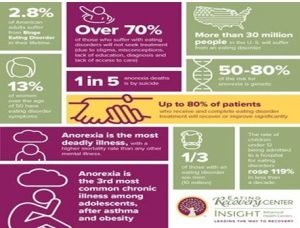It is indeed a true fact that the 2020 corona virus pandemic had an immense effect on our lifestyle. Some may be good but the negative effects are undeniably large. One of the major issues that this pandemic raised was the substantial increase in stress, anxiety and depression disorders in the population. Notably, groups at risk for mental health concerns, such as eating disorders (EDs), may be disproportionately impacted during this crisis (Reger et al., 2020), with initial data from COVID related restrictions in Spain describing more than one in three individuals (12/32) with an ED reporting worsening symptomatology (Fernandez-Aranda et al., 2020). And on top of all that, the fire like spread of the virus did nothing but fear in many of us. In the end it is evident that the pandemic has left a critical psychological scar in all of us.
Eating disorders may not particularly mean less eating; over eating is counted and treated the same. It is also very essential to clear off the stigma that eating disorder is a ‘white woman’s disease’. No, it can happen to anyone despite color or nationality. These disorders may not sound so fatal as corona does, but they are equally nasty and have caused noticeable fatality, even more so than corona itself. Moderate exercise is universally touted as a positive health behavior for physical and psychological well-being, with CDC guidelines advocating for 150 minutes of physical activity per week (USDHHS, 2008). With fitness centers closed en masse and outdoor physical activity complicated by physical distancing efforts, those with heightened weight and shape concerns may experience increased distress.
Few of the most commonly seen eating disorders are Anorexia Nervosa, Bulimia Nervosa and the newly trending Binge eating disorder. Before delving deep, it is important to know what kind of disorders they are:
- Binge eating, which is characterized by excessive eating, beyond the point of feeling full. This is the most common eating disorder in the U.S.
- Bulimia nervosa, which begins with binging, followed by purging, laxative abuse, or compensatory exercise. People suffering from bulimia can be either underweight, a healthy weight or overweight.
- Anorexia nervosa, which can include avoiding food, severely restricting food and/or eating very small quantities of certain foods. Someone battling anorexia may view themselves as overweight, regardless if they are dangerously underweight.
(Reference: https://www.goodhousekeeping.com/health/wellness/a34719708/coronavirus-eating-disorders-triggers-issues/ )
All these three major disorders build their base on top of any negative psychological element that we possess. To put it more objectively, anxiety and stress are major reasons for binge eating. It’s quite an obvious fact that we all feel like eating snacks when we feel stressed or maybe for a few eating sweets help to calm their nerves. On that same basis an overly stressed mind reaches out to food and in particular junk food.

During the lockdown all over the world people have been feeling either anxious or stressed, which greatly paved the way for these disorders to develop. In 2019, an estimated two billion individuals worldwide experienced moderate or severe food insecurity (i.e., scarcity, reduced access to, or difficulty acquiring safe, nutritionally adequate foods; Food and Agriculture Organization of the United Nations, 2019), and early estimates from Western countries suggest these numbers have risen exponentially during the initial weeks of the COVID-19 pandemic (Loopstra, 2020). In many, especially those who suffer from anxiety of their food stock running out, they decide to starve themselves and thus falling right into the arms of eating disorders..
Youngsters living alone during the lockdown majorly “forgot” to eat and they obliviously danced to the notes of these disorders. On another note, the social media usage during the lockdown got extremely high because of all the free time people were given. The social media celebrities and influencers that projected the ‘ideal body; image were also a contributing factor to these disorders, especially anorexia and bulimia. All the ideas of ‘glow up’ by reducing their weight and changing their appearance could have also been the traps that lead them to these disorders. I mean it was their fault for choosing appearance upgrade instead of attitude upgrade.
But all these causes are not definite, people who are aware of their own self are not that easily taken advantage of, even by these disorders. The social distancing also contributed to the disorders. Though the help in reducing the virus spread, physical distancing also increases the likelihood of experiencing isolation and loneliness. Loneliness and isolation are risk factors for psychological issues broadly as well as in the development and maintenance of EDs. The lockdown period is hard for everyone, in more than just one way, but even then disturbing our bodily peace is not the answer. It may sound easy, actually even harmless- ‘forgetting to eat’, wanting to look a litter slimmer’, ‘just grabbing a bite to feel calm’- but these are the starting line from which we sprint towards the disorders.
There are numerous ways that may help you from getting stuck in these disorders. One of the major reasons for bulimia and anorexia is the projection of toxic body images, thus avoiding exposure to them would help. Taking time to do some light workouts like cardio are always great ways to get rid of that stress. Trying something new, say Mandala arts or yoga or even break dance can become your savior. Now that we have such great access to new hobbies and others via the internet, why not exploit it! To have a proper eating schedule, always have a timer set for that. If you are living alone and taking care of your own meals, try new recipes every day or pre-plan your food for that day to make sure you don’t run out of the ingredients soon. It is okay to feel stressed, you are not alone but remember, what we eat makes the most of us physically, so understand the importance and keep pushing your limits to stay on the track.
